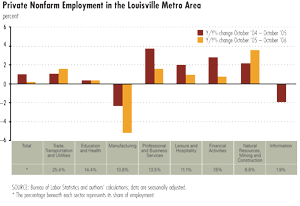District Overview: Louisville's Job Growth Lags on Many Fronts
The number of private nonfarm jobs in the Louisville metro area increased by 0.2 percent—or just 1,200—between October 2005 and October 2006, according to estimates from the Bureau of Labor Statistics. This was a significant slowing of job growth compared to the previous 12-month period, when nearly three times as many jobs were added. The metro area has underperformed the country as a whole, too: Between October 2005 and October 2006, private nonfarm employment in the United States rose by 1.6 percent.
On the other hand, in the 2006 calendar year through October, the number of private-sector jobs in the Louisville area rose by 0.7 percent at an annualized rate, indicating that job growth has been accelerating somewhat.
As is usually the case, the employment numbers for the metro area as a whole mask significant differences in performance across sectors. For example, in contrast with trends in total employment, the two largest sectors in Louisville—trade, transportation and utilities; and education and health—have been generating more jobs than previously. Also, the rate of job loss in manufacturing has been accelerating, while jobs have continued to be added in all other sectors. The pattern across industries is detailed by the figure.
Six of the eight private sectors contributed positively to the employment growth since October 2005. Trade, transportation and utilities—the largest sector in Louisville—grew by 1.6 percent since October 2005. That percentage was larger than the previous year’s growth rate and outpaced the 0.5 percent national-level growth for the sector.
Louisville’s second-largest sector, education and health services, continued to have slight positive employment growth since October 2004; the most recent year-over-year growth rate (0.4 percent) was unchanged from the previous 12-month period. This sector lagged significantly behind the rest of the country, which saw 2.6 percent growth from October 2005 to October 2006.
Manufacturing employment fell by 5.2 percent from October 2005 to October 2006, or more than 4,000 jobs, a sharp worsening over the previous year’s 2.4 percent decrease. In contrast, employment in the U.S. manufacturing sector experienced a decrease of only 0.1 percent over the same period.
Professional and business services, the area’s fourth-largest sector, has been one of the strongest sectors since October 2004. From October 2004 to October 2005, the number of jobs rose by 3.8 percent. For the next 12 months, employment in this sector grew by 1.6 percent. In comparison, the U.S. sector grew by 2.7 percent from October 2005 to October 2006; this growth was the largest across all of the U.S. sectors.
The fifth-largest sector in Louisville, leisure and hospitality, continued to have gains in employment but at a much slower pace. The year-over-year growth rate in October 2006 was 1 percent, which was half of the previous year-over-year rate. The U.S. sector grew by 2.6 percent since October 2005.
The financial activities sector had a similar experience. The most recent year-over-year rate was 0.8 percent, less than one-third of the previous year-over-year rate. For the country, the rate was 1.9 percent for the period from October 2005 until October 2006.
Natural resources, mining and construction had larger growth than any other sector in Louisville since October 2005. It is also the only sector to have continuous upward growth since October 2004. The year-over-year growth rate for October 2006 was 3.6 percent, and the pace for the first 10 months of 2006 was 6.3 percent. The U.S. sector had 2.4 percent growth since October 2005.
Louisville’s smallest sector, information, experienced no change in employment since October 2005. Employment in the U.S. information sector rose 0.1 percent from October 2005 to October 2006.
Views expressed in Regional Economist are not necessarily those of the St. Louis Fed or Federal Reserve System.
For the latest insights from our economists and other St. Louis Fed experts, visit On the Economy and subscribe.
Email Us



